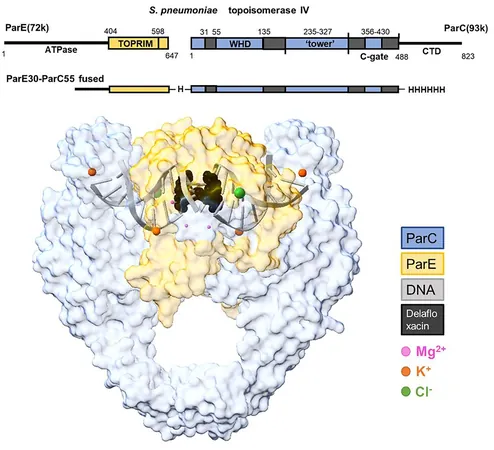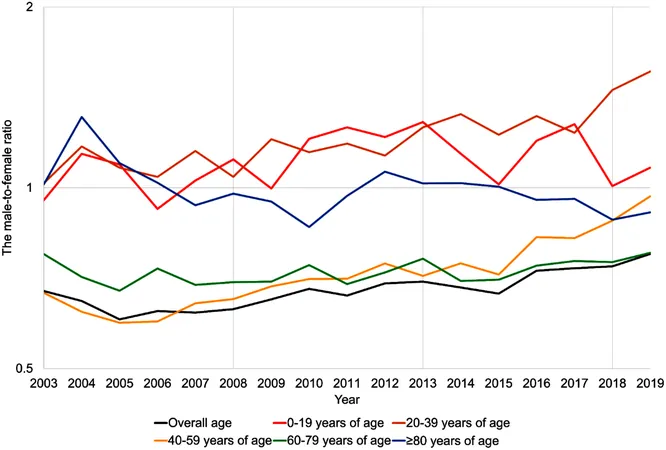
Revolutionary X-ray Technique Unlocks New Frontiers in Antibiotic Drug Design!
2024-10-04
Groundbreaking Study on X-ray Techniques
In a groundbreaking study, researchers from City St George's, University of London, have pioneered a cutting-edge ultra-high precision X-ray scattering technique that reveals the location and identity of crucial metal ions in bacteria. This discovery is key to enhancing the effectiveness of antibiotics, particularly in the battle against drug-resistant infections.
The Role of Topoisomerase IV in Bacterial Infections
Many bacteria synthesize an enzyme known as topoisomerase IV, which plays a vital role in untangling and separating newly replicated DNA. This process is essential for bacterial cell division and proliferation. Antibacterial agents, such as fluoroquinolones—including delafloxacin—target these bacteria by specifically binding to magnesium ions within the topoisomerase IV complex. By binding to this structure, fluoroquinolones block the enzymatic action of topoisomerase, effectively halting bacterial reproduction and leading to cell death.
Innovative Discovery of Metal Ion Locations
Using X-ray beams at two distinct energy levels, the research team successfully pinpointed where magnesium, potassium, and chloride ions reside within the enzyme complex. This achievement marks a world-first in bacterial research, as the identification of these ions will pave the way for the development of innovative antibacterial drugs targeting a wide range of diseases.
Publication and Collaborative Research Efforts
Published in the esteemed Proceedings of the National Academy of Sciences, this research was spearheaded by Professor Mark Fisher from the Neuroscience and Cell Biology Research Institute, in partnership with scientists from Imperial College and Diamond Light Source. Professor Fisher remarked, “This breakthrough allows us to identify metal ion locations and identities with unprecedented precision, potentially revolutionizing enzymology and the future of drug development.”
Understanding the X-ray Scattering Technique
The technique of X-ray scattering examines the energy emissions from metal ions when exposed to X-ray beams. By analyzing these emissions at varying energy levels, researchers can accurately determine the types of metal ions present and their spatial arrangements within biological structures.
Impact on Pneumococcal Disease and Antibiotic Resistance
Focusing on the delafloxacin-bound topoisomerase IV of *Streptococcus pneumoniae*—the primary culprit behind community-acquired pneumonia as well as severe illnesses like meningitis and sepsis—this research has urgent real-world implications. Pneumococcal pneumonia is particularly fierce among infants and the elderly, contributing to approximately 1 million fatalities annually among children under five globally.
Future Prospects for Drug Design
Professor Fisher hopes that this enhanced understanding of fluoroquinolones and their interactions with topoisomerase will lead to new drug designs aimed at combating the relentless rise of drug-resistant bacteria. This study is part of a long-standing collaborative effort with structural biologist and co-lead Professor Mark Sanderson at Imperial, who has been pivotal in elucidating the structures of numerous topoisomerase-drug complexes critical to advancing antibacterial therapies.
The Urgency for New Solutions
As bacteria become increasingly resilient against existing antibiotics, the urgency for new solutions grows. This research may be the key to unlocking novel treatment strategies and ensuring the effectiveness of antibiotics in a world where resistance is a looming threat.



 Brasil (PT)
Brasil (PT)
 Canada (EN)
Canada (EN)
 Chile (ES)
Chile (ES)
 España (ES)
España (ES)
 France (FR)
France (FR)
 Hong Kong (EN)
Hong Kong (EN)
 Italia (IT)
Italia (IT)
 日本 (JA)
日本 (JA)
 Magyarország (HU)
Magyarország (HU)
 Norge (NO)
Norge (NO)
 Polska (PL)
Polska (PL)
 Schweiz (DE)
Schweiz (DE)
 Singapore (EN)
Singapore (EN)
 Sverige (SV)
Sverige (SV)
 Suomi (FI)
Suomi (FI)
 Türkiye (TR)
Türkiye (TR)